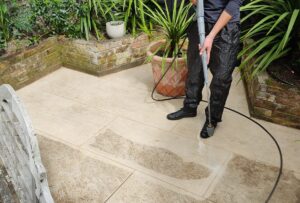
Fence installation: How to do it and how much it costs?
- By professionalgardening
professional gardening2016@gmail.com
+44 7492 657585
Priory Gardens, UK

Backyard fence installation sounds like a lot of work. Because it is. Takes more than just choosing a fence to fit the outdoor aesthetic and then purchasing it. To simplify the process as much as possible for you, we have created this short guide on professional garden fencing.
If you are planning on installing a garden fence anytime soon, it is important to consider how much it costs and how to do it properly. Make sure to check this article to get all of the information!
The first thing on the agenda for a new fencing project is to get accustomed to the work. The best way to learn how to proceed is to get acquainted with the basics of the task at hand. We have prepared this short list of fence installation steps that will make the job a breeze:
Now that you know the steps, let’s dive into the details and learn how to install a fence properly and how much fence installation costs.
Fence installation requires careful planning. It is not only buying the fence and putting it up. The whole process takes time and dedication. Because you need to make sure to order the right amount of materials, reduce waste and optimize the overall costs.
Another factor that requires planning is the legal requirements. Each property has an allowance of a certain fence height. So you need to be compliant with the housing regulations. You can check them in any local planning office.
Planning is also required because in some areas your outdoor space might have obstacles, like underground structures, pipes, and cables. These need to stay intact upon installing the garden fence. So your job is to allocate them and ensure to avoid them along the fence line where there would be holes.
The best time to install a fence is during spring and fall to avoid the too hot and too cold weather. Another climate note we’d like to leave is to ensure you are not working in a wet backyard.
Last but not least, think about the post length. Depending on the ground conditions and landscape features you have in your garden, you might need a different fence post length. After all, the goal is to set firm, stable, and straight posts.
An imperative step in the planning process is to gather all the materials for fence installation. Here is a summed up list of what tools you would need if you want to install garden fencing:
Before you proceed with fence installation, it is important to note that the working space should be cleared up. Both for safety and easy work process.
That includes removing all kinds of debris, plants, roots, and rocks from the working area. The site needs to be bare, to ensure optimal results. Once the edges of your garden have been cleared up along the fence lines, you can start prepping the ground for installing the postholes.
And remember – to set a stable fence, the first thing you need is a strong foundation. In this case, concrete would be the best choice. So our advice is to lay concrete in each posthole – it takes more time but will guarantee stable construction and unmoving posts for your fence installation.
Start by marking out the position of each garden fencing post. Go along the line where you want the fence to be installed. Take a spade and begin digging a posthole. As you go deeper into the soil, consider the appropriate length of the fence post you purchased.
The typical posthole size is 60cm deep by 30cm square, but anyway – check the relevant sizing recommendations. The next step is to add 2cm of gravel to the bottom of the hole. It will grant good water drainage and will elongate the fencing post’s life and stability.
Then place the first fence post into the hole. Check if the post is in an absolutely vertical position, using a carpenter’s level. Once the post is aligned, it is time to hold it in place by screwing timber props into it.
The next step is adding the concrete mix to fill up the hole, and literally – seal the deal. Fill up but leave 2-3cm before the soil line. Check if the post is still vertical and if so – make a gentle outer slope on the concrete surface on all post sides. Wait for the concrete mix to set and remove the timber parts.
If the posts are wooden – apply a wood preserver to elongate the life of the posts and the garden fencing. Repeat that process for all fencing posts.
Just like any building and gardening task, fence installation requires protective gear. Our professional gardening advice is to wear garden gloves, safety goggles, and a dust mask. Gloves will help you a lot when working with wood and wood preserver. Mask and safety eyewear will assure you stay protected when drilling and working with the concrete mixture.
Another important thing to remember during the fence installation process is to follow manufacturer instructions listed for the gear, materials, wood preserver, and concrete you are using.
Let’s not forget safe disposal. The job of building a fence often comes with wastage. For that purpose, try to reach out to your nearest recycling centre and ask them to guide you on how to dispose of offcuts and debris safely.
Once all posts are set and the fence is installed, there is one last thing to do. And that is – increase the longevity of the garden fencing. Basic maintenance is essential for the well-being of a fence in the long run.
Here is a list of things you can do to properly care for fencing installations:
Fence installation is not an easy task, nor it is a cheap one. There are a few things to have in mind when setting a budget for a new garden fence. And a few things to consider in your expense calculations when buying a fence and fencing materials.
Let’s go over all the factors that play a role in how much does fencing cost:
The average cost of a fencing installation is around 2500£. But there are many variables that can severely alter that cost. Such as fence material, design, length of fencing, preservatives, paint, concrete mix, transportation, waste disposal, hiring professional help, etc.
In general, the price range for garden fencing is pretty big. In total, fence installation can cost between £800 and £4000.
Panels are probably going to be your biggest spending upon fence installation. Each type of board costs differently, in terms of width, length, material, longevity, and quality.
Here is an average price per board:
Gate pricing depends a lot on the type of fence you decide to install. A gate should match the fence style, material, and design. So have in mind you will have limited gate options to choose from and have to be ready for the expense of purchasing it. On average wooden garden fencing gates cost around £450. And the metal gates cost approximately £180.
Rails are some of the cheapest elements in garden fencing. Basic wooden ones can be found at a price of £7-£10 each, while the vinyl and composite rails price can range from £15 to £100.
Most people who want to install a fence contract companies to bring materials, posts and panels to the site. Transportation labour is not free and the pricing varies depending on company policy, as well as the size, weight and type of fences/materials being delivered.
As you probably realized already, the fence installation task is also not for everyone. Therefore, when the job is more complicated – it is better to hire professional landscapers. That’s what most people do to ensure the job is done perfectly. But of course, it comes as no surprise such expert labour is paid.
Fence installers will charge you for installation time, amount of work to do, and fence replacement. The duration of the procedure is determined by the size of the fencing system, the materials and the lot space that needs to be covered.
If you have a small yard that needs up to 10 meters of fencing, fence installation can be done in a day. For bigger spaces, the job will take longer, and logically – will cost more. The average installer would charge between £300 to £400 per day. For additional services like sealing and painting, the professional should take around £10-£20 per square metre.
Let’s not forget wood preservatives, concrete, paint, fence posts, and all the other additional expenses that come with fence installation. Depending on the manufacturer and the quality of the supplemental products used, the final cost estimate might vary.
Additional materials like preservatives, fence paint, and concrete mixture can be totalled at around £400 or less. As for the garden clearance and leftover debris, a professional waste removal company might charge you something between £50 to £200. Recycling centres might cost you a bit less money.
If you are installing a new fence to replace an old one, you might need to pay professionals for fence removal. The service costs around £400 on average.

Meet Nikolay, a talented blog and content writer with years of experience creating engaging and informative content for a variety of industries.


TO CELEBRATE OUR NEW WEBSITE WE WANT TO GIVE YOU
